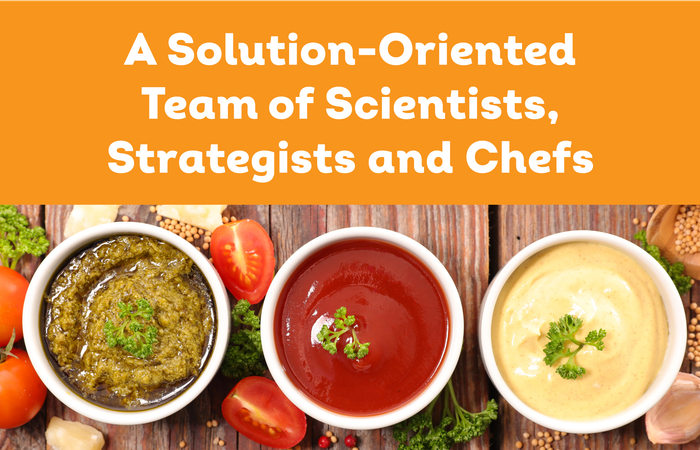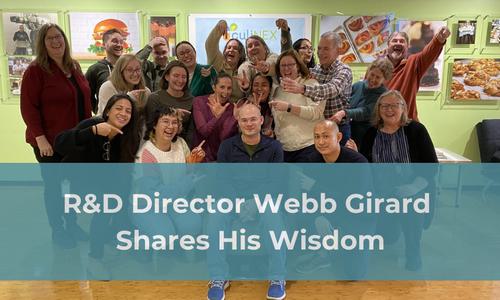
A Solution-Oriented Team of Scientists, Strategists and Chefs
The CuliNEX Secret S.A.U.C.E. behind powerful partnerships
Food product innovation today is a complex and critical undertaking. Launching a new consumer food product, reformulating an existing one, or innovating with ingredients and flavors requires a wide array of capabilities: culinary formulation, ingredient sourcing, operational and co-man experience—not to mention the organizational systems and communication processes to get that product into production on time and on budget. If your food company does not possess those elements in-house, or doesn’t currently have the capacity, you can still meet your goals of advancing innovation and achieving a successful launch.
All it takes is a dash of Secret S.A.U.C.E. At CuliNEX we are Solution-oriented, Agile, United, Curious, and Exceptional. And it’s “secret” because we let our clients shine and value their confidentiality. In this blog series, we highlight each ingredient in the CuliNEX Secret S.A.U.C.E. To showcase how we become the essential partner for so many food product innovation teams.
“We're always driving toward something, taking action, not waiting for instruction to move forward, but going out to find solutions,” said Webb Girard, Senior Director of R&D. The CuliNEX team maintains a bias for action, focusing on what truly matters to achieve meaningful outcomes.
Solution-oriented
A solution-oriented team makes plans, and when challenges arise, they stretch to learn and identify alternatives. Product developers iterate, and iterate again, revising and assessing with each step to achieve an optimal solution.
If a client is looking, to formulate a delicious vegan chocolate chip cookie, for example. There are many potential variables in creating a plant-based, dairy-free version of this chewy, rich treat. Each variable offers benefits—and challenges. Knowing this, the team at CuliNEX takes on such a project in a solution-oriented, iterative process.
A typical development project or new product exploration encompasses two or three rounds of tests. For example, palm oil could substitute for butter, but it has a different melting point and doesn’t deliver butter’s rich, creamy flavor. Eggs would need to be replaced as well, which means finding solutions that can deliver the puffiness and binding properties of the eggs.
Addressing Complexities
“With every guardrail, the solutions are made more complex,” said Girard. More complexity means greater associated costs. For example, the ideal technology needed to prepare a food might not exist. The ingredients might be difficult to source. The cost of labor might be high.
Addressing these complexities is a daily practice at CuliNEX. “If solution pathways are blocked,” said Girard, “It’s our job to open them back up. The ideal ingredient for a formulation may not be commercially available. So we ask, ‘What can we do to replace that ingredient with something that gives us the same texture and flavor?’”
Solution-oriented Innovation
Much of what we do has never been done before. With no established roadmaps, it’s up to us to forge new paths. Because the CuliNEX team is experienced in food science, culinary arts, ingredient sourcing, and co-manufacturing elements of bringing a food product to market, we can focus on the broad range of elements that contribute to successful outcomes for our clients. The team seeks innovative alternatives and does not waste time pursuing dead ends. “We’re always ensuring we’re looking at the right variables,” said Girard.
Solutions also come from unconventional thinking, which is encouraged at CuliNEX and strengthened by the range of skills and experience on our team. Chefs, scientists, and technologists with varied backgrounds can transfer knowledge, technologies, and processes from one field and apply them to another. For example, to effectively produce foods such as beef jerky, dried vegetables, or cereals, why not look outside the food industry for drying technologies? “We looked at the techniques used for drying textile goods,” said Girard. “Drying jerky is just drying.”
Seeking innovative solutions requires a healthy attitude about failure. Failure can be positive, because it often sparks outside-the-box thinking. “As an R&D team, we are presented with failure on a daily basis,” said Girard. “If we knew the answer, we wouldn’t have to research.” When one experiment does not succeed, it often reveals new insights. And from there, new possibilities—and new solutions—can arise.
Communication is Vital
Vital to this solution-oriented iterative approach is continuous communication with clients. CuliNEX development teams regularly meet with their clients to discuss, consider, and come to terms with the research outcomes.
Because our projects often explore new ways to meet consumer and client demands, “we have to be very thoughtful about how we spend our time,” said Girard. “We act on something, then iterate, evaluate, and move forward.” Being solution-oriented is not just a mindset but a commitment to driving positive change and achieving client goals while balancing the needs, priorities, and capabilities of many factors beyond our control.
Facing challenges in food product development? Partner with CuliNEX to find innovative, solution-driven strategies that bring your vision to life.
CuliNEX delivers unmatched Clean Label innovation. Read more about the advantages of the CuliNEX Secret S.A.U.C.E.:
S stands for Solution-Oriented
A stands for Agile
U stands for United
C stands for Curious
E stands for Exceptional








